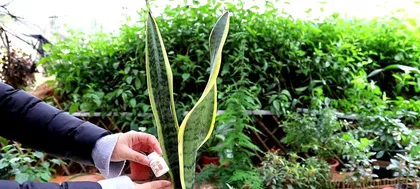Snake plant is a popular plant, not only for its high ornamental value but also for its excellent air-purifying function. However, when winter arrives, the growth of the snake plant will be greatly limited. So how can we ensure that the snake plant grows well in winter? Here is a detailed guide on the complete winter care for the snake plant.

I. Suitable Temperature is Key
Snake plants prefer a warm environment, but in winter, they need to avoid excessively low temperatures. Generally, a temperature between 15°C and 25°C is most suitable. If the indoor temperature is too low, you can consider adding heating equipment.
II. Increase Light Exposure
Snake plants love sunlight, but in winter, sunlight is insufficient. It is recommended to increase the light exposure, allowing the snake plant to get at least 2-3 hours of sun daily for sufficient photosynthesis.

III. Pay Attention to Ventilation
Snake plants need air circulation, but indoor temperatures are lower in winter. Therefore, while ensuring ventilation, it's important to prevent cold air from blowing directly onto the plants.
IV. Avoid Overwatering
Snake plants grow slower in winter, so watering should be moderate. It's best to water only after the soil surface has dried, and water thoroughly each time. Avoid overwatering, as it can easily lead to root rot.
V. Remove Fallen Leaves Promptly
Snake plants also drop leaves in winter. Clean them up promptly to prevent rotting leaves from affecting the health of the entire plant.

VI. Apply Fertilizer Appropriately
Snake plants grow slowly in winter and do not need frequent fertilization. Once every two months is sufficient, and it should be done with diluted liquid fertilizer.
VII. Pay Attention to Cold Protection
Cold weather can easily damage snake plants, so it's necessary to take cold protection measures. You can cover the soil surface with an insulating material, such as dry grass or hemp rope.
VIII. Pay Attention to Pest and Disease Control
Snake plants are also prone to pests and diseases in winter, so prevention is important. You can use environmentally friendly pesticides for control and regularly check the plants for any signs of disease.
IX. Maintain Soil Moisture
The weather is dry in winter, and snake plants can be affected, so it's important to maintain soil moisture. However, avoid overwatering to prevent root rot.
X. Avoid Excessive Pruning
Snake plants grow slowly in winter, so frequent pruning is not necessary. Only perform moderate pruning when needed.
XI. Avoid Strong Winds
It's windy in winter, which can easily blow off leaves or cause the plant to lean. Therefore, avoid placing snake plants near vents or too close to windows.
XII. Pay Attention to Irrigation Water Quality
The quality of irrigation water greatly affects the growth of snake plants. Avoid using water containing chlorine or other chemicals for watering. It's best to use tap water or purified water for watering.
XIII. Replace Soil Regularly
Snake plants grow slowly in winter and do not need frequent soil replacement, but it shouldn't be left too long without changing. Generally, replacing it once a year is sufficient, while also paying attention to the adaptability of the new soil.
XIV. Avoid Direct Sunlight
Although snake plants love sunlight, the sun is weaker in winter, and excessive exposure can harm them. Therefore, avoid direct sunlight.
XV.
The winter growth of snake plants requires us to take various measures, including increasing light exposure, maintaining suitable temperatures, moderate watering and fertilizing, and cleaning up fallen leaves. Only in this way can we help the snake plant get through a healthy and pleasant winter.